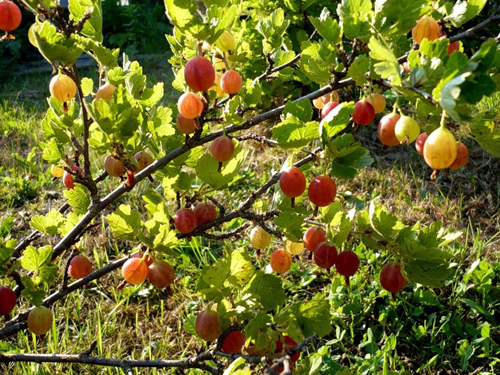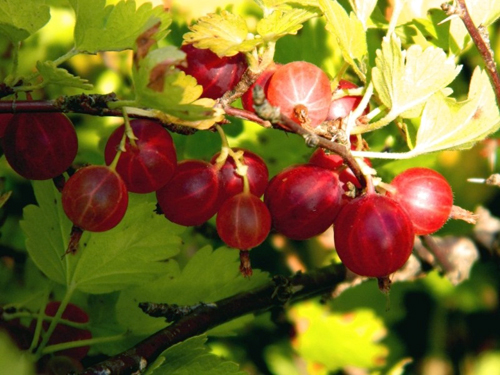Gooseberry variety Russian
The old varieties of gooseberries that are still cultivated have proven their reliability. Among such time-tested varieties is Russian, which is still popular among cultural connoisseurs. They took him out after the war, in 1949, at the V.I. I.V. Michurin. Author - K.D. Sergeeva, who pollinated Careless gooseberries with a mixture of pollen collected from Oregon, Houghton and Curry. In the State Register of Breeding Achievements of Russia, the variety has been listed since 1959. Admission to cultivation is available in almost all regions of the country - Central, Central Black Earth, North, North-West, Volgo-Vyatka, Middle Volga, North Caucasian, West Siberian, Nizhnevolzhsky, East Siberian and Far Eastern regions.

Description
The bush is medium-sized, sometimes vigorous. Height is about 150 cm. The crown of the Russian is moderately thickened, branching is weak. At a young age, the plant is spreading, then it becomes more compact. Young shoots of gooseberry are medium or thick, not pubescent, curved in an arc, so the tops are hanging. The bark is light green, anthocyanin coloration appears in the upper part. The bark of lignified shoots brightens. The bush of this variety can be called medium-spiked, the thorns are mostly single, light, straight, of moderate length and thickness. They grow perpendicular to the shoot or obliquely upward, usually concentrated in the lower part of the shoot. Buds are small, oblong, with a pointed apex, not pubescent, brown, growing deviating from the shoot.
The leaves of the Russian are medium in size, bright green, not pubescent. The surface of the gooseberry leaf plate is matte or slightly shiny, leathery, folded, concave. The teeth are small, slightly bent, with a blunt apex. The main veins are not colored. The leaf of this variety has five lobes, the notches between them are medium in size. The middle lobe is slightly larger than the lateral lobes, with rounded edges at the lateral edges. The lateral lobes are medium in size, the tops are pointed and directed upward, the angle between the veins of the lateral lobes is acute. The basal lobes are underdeveloped, with open veins. The angle between the straight base of the leaf plate and the petiole is straight. The petiole is of moderate thickness and length, has very sparse pubescence in the lower part, is located at an angle of 45 ° to the shoot. The flowers are small, pale-colored. The brush consists of one or two flowers. Sepals are pale, free, slightly bent upward.

Gooseberries are medium to large in size, weighing 3.0 - 6.0 grams, oval or elliptical. During ripeness, they turn dark red. Because of this color, the variety is often called Russian red. The skin is thin, but firm, not pubescent, there is a waxy coating. When ripe, a strong venation becomes clearly visible, veins are weakly branched, pink in color. The pulp is tender, juicy and aromatic. The taste is sweet and sour, very pleasant, "table", estimated at 4.0 - 4.4 points. The calyx is rather large, full, closed. The peduncle is light green, hairless, short and slender. 100 grams of raw material contains: sugars - 9.9%, titrated acids - 1.8%, ascorbic acid - 23.6 - 41.6 mg.
This gooseberry has a variety - Russian yellow. Although it appeared later, it is not inferior in popularity to its predecessor. They took her out in the same research institute named after I. I.V. Michurin, but has been listed in the State Register since 1974. In appearance and characteristics, it is similar to the described variety, but its berries are larger and the yield is slightly higher.
Characteristics
- The early maturity of our hero is high - a full harvest can be removed for 2 - 3 years after planting a 2-year-old seedling;
- in terms of ripening, the crop is mid-season, which means that in regions with a temperate climate, the fruits ripen by July 25, but in the southern regions the harvest may come a little earlier, and in cool regions - a little later. The berries ripen slowly;

- the yield of Russkiy is high, according to VNIISPK, this figure is 2.1 - 5.7 kg per bush, and the State Register declares higher productivity - from 4 to 10 kg per plant;
- gooseberries are self-fertile, so they can be grown in single plantings;
- the winter hardiness of the variety is quite high, but in too harsh winters it can freeze;
- the drought resistance of the plant is very good, this saves it in hot weather, when for some reason watering is delayed;
- plant immunity is high, first of all, Russian is valued for its excellent resistance to powdery mildew, resistant to spheroteca;
- in one place, the variety can bear fruit for up to 15 years, then the yield decreases;
- fruit transportability is good;
- the way of using the crop is universal. Healthy berries in their natural form will well strengthen the immunity of adults and children. And for the winter, every housewife will be able to prepare delicious preparations - gooseberries, grated with sugar, royal jam with cherry leaves, jam, pie filling and even liqueur.
Planting and leaving
Russian prefers well-lit areas with loose and fertile soil, the acidity of which is moderately neutral or slightly acidic. The subsoil water level is not higher than 1.5 meters to the surface. The landing time is chosen taking into account the climatic characteristics of the region. Given the size of the bush, the distance to neighboring plants is about 1.5 meters, to fences or walls of the building - at least 1 meter. The variety is responsive to feeding, loves a combination of organic matter and mineral fertilizers. Pruning is perhaps the main step in caring for gooseberries. During planting, the seedling is cut in half or 2/3. Then, annually in spring or autumn, old and diseased branches are removed. Pruning is carried out at soil level so that no hemp remains. The rest of the care methods are no different from the usual.
Russian is a reliable and fruitful variety that also has strong immunity. Winter hardiness allows you to grow it in almost all regions, with the exception of the Ural. The berries are of high commercial quality and are suitable for processing. For many years of cultivation of this gooseberry, no obvious shortcomings have been identified in it. Inconvenience can only bring the spreading of the bush at a young age.








